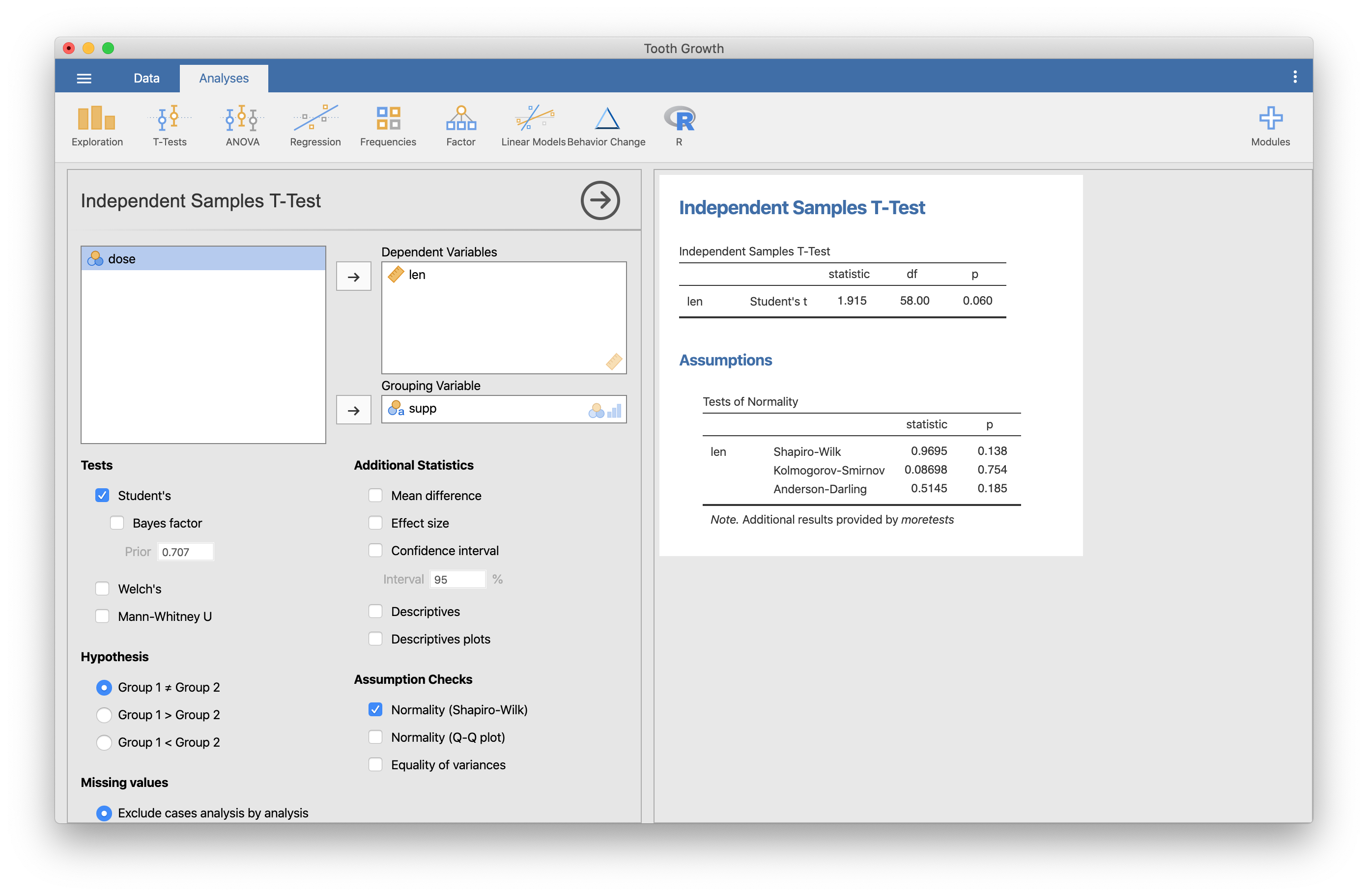Page 1 of 2
Tests of normalities
Posted: Tue Oct 23, 2018 7:00 am
by alquirel
Hi,
First of all, thank you for this beautiful and successful application. I study on medical sciences and I am very familiar with SPSS, like almost all other medicine specialists. And as written in statistics textbooks, while testing the normality of data if sample size is more than 50, we shall use Kolmogorov-Smirnov test rather than Shapiro-Wilk test.
Do you consider this? Maybe there is an option in Jamovi for K-S and I couldn’t find it, I don’t know. If so, sorry.
The reason of this topic is in Development Forum, I am very good at Javascript and NodeJS, but I am not good at R. I think I can achieve this by a module with some effort but I don’t think it would be useful in a separate menu rather than in T-Test analyse options.
Re: Tests of normalities
Posted: Tue Oct 23, 2018 7:48 am
by jonathon
hmm, yeah. the issue is that we want to provide a lot of features, but not so many that we become overwhelming for new users.
K-S is a bit in the middle ...
i'll think about it.
cheers
Re: Tests of normalities
Posted: Sat Feb 16, 2019 10:25 am
by smithdev
Hello,
First of all, my sincere congratulations for this excelent piece of software, which my save us from the horror of SPSS!
I second the request for the Kolmogorov-Smirnov test.
Will you also consider the inclusion of the Brown-Forsythe (B-F) Test (for testing the assumption of equal variances in ANOVA)?
Thank you very much for all you work!
Re: Tests of normalities
Posted: Thu May 30, 2019 2:24 pm
by glen
I'd use K-S as well. I am switching from SPSS to jamovi for teaching this year and have always taught the students to use K-S for larger sample sizes. Would be so handy to have it beside the SW box.
Re: Tests of normalities
Posted: Thu Jul 25, 2019 11:14 pm
by Wake
Plus one for Kolmogorov-Smirnov, especially for regression where the sample sizes are usually too big for Shapiro-Wilk.
In terms of reducing options I think you could have a normality test appear whenever you ask for a Q-Q Plot of Residuals and then present the S-W or K-S test based on the degrees of freedom. I'm going to find it challenging to teach the difference between a good enough Q-Q plot and one that's a cause for concern when I don't feel confident on knowing where the boundary is myself (since I rarely pay much attention to them). A normality test quantifies the evidence for deviation which makes life easier, and a histogram of the residuals is far easier to interpret than a plot where the normal curve has been straightened..
Cheers,
Wake
Re: Tests of normalities
Posted: Sat Aug 24, 2019 11:46 am
by jonathon
you'll now find a module in the jamovi library called 'moretests', which adds K-S and A-D normality tests to a number of the jamovi analyses. (we've added a new 'addon' system, that let's modules adjust the behaviour of existing analyses).
cheers
jonathon
Re: Tests of normalities
Posted: Wed Sep 18, 2019 9:58 am
by iss
Hello, I have installed the 'moretests' module, however I can't find the Kolmogorov-Smirnov test (under Independent T-test I've only got Student's, Welch's and Mann-Whitney U). Could you please point me in the right direction?
Re: Tests of normalities
Posted: Wed Sep 18, 2019 10:45 pm
by jonathon
hi,
moretests is what we call an "addon", where it adds results to existing analyses. just run the t-test or ANOVA as usual, and choose 'normality tests' (granted, there's an issue with 'normality tests' still be labeled as shapiro-wilk). see here:

- Screen Shot 2019-09-19 at 08.43.28.png (796.64 KiB) Viewed 35345 times
cheers
jonathon
Re: Tests of normalities
Posted: Thu Sep 19, 2019 8:08 am
by iss
Oh I see. Thanks
Re: Tests of normalities
Posted: Sun Sep 22, 2019 11:30 pm
by pullume
Hello
Im new to statistics. Im having an issue with the Shapiro-wilks analysis.
On the Jamovi video for one-sample t-test it says that the test for normality presents results in p-values.
However im getting something totally different for my assignment analysis.
I get these results with e's in them - 6.720e-7 and 1.722e-4 . Can you explain these please?


